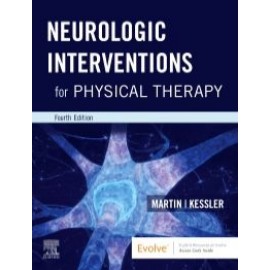Neurologic Interventions for Physical Therapy, 4th Edition - Suzanne "Tink" Martin
Descripcion del producto
| ISBN Number | 9780323661751 |
| Main Author | By Suzanne Tink Martin, MACT, PT and Mary Kessler, MHS, PT |
| Copyright Year | 2021 |
| Edition Number | 4 |
| Format | Book |
| Trim | 276 x 216 (8 1/2 x 10 7/8) |
| Illustrations | Approx. 740 illustrations (175 in full color) |
| Imprint | Elsevier |
| Page Count | 544 |
| Publication Date | 28 May 2020 |
| Stock Status | IN STOCK |
Book Description
Whether your goal is to be a physical therapist or a physical therapist assistant this book?s comprehensive content will give you in-depth knowledge on the role of neurologic rehabilitation in the treatment of adults and children with neuromuscular impairments and explores concepts in neuroanatomy motor control and motor learning and motor development. Neurologic Interventions for Physical Therapy 4th Edition provides a current framework for neurologic practice and focuses on the precise links between the pathophysiology of neurologic conditions and possible interventions to improve movement outcomes. The text also includes a new chapter on Autism Spectrum Disorder. Helpful learning aids in each chapter include objectives and summaries open-ended review questions line drawings and photos step-by-step illustrated intervention boxes tables and charts.
New to this edition
-
UPDATED! Best evidence for interventions; clear, concise tables; graphics and pictures; and current literature engage you in the spectrum of neurologic conditions and interventions.
- NEW! Autism Spectrum Disorder chapter covers clinical features, diagnosis, and intervention, with a special focus on using play and aquatics, to support the integral role of physical therapy in working with children and families with autism.
- NEW! Common threads throughout the Children section focus on motor competence as a driving force in a child?s cognitive and language development and highlight how meaningful, fun activities with family and friends encourage children with disabilities to participate.
- UPDATED! Neuroanatomy chapter provides a more comprehensive review on nervous system structures and their contributions to patient function and recovery after an injury or neurologic condition.
- UPDATED! Adult chapters feature updated information on medical and pharmacological management.
- NEW! The Core Set of Outcome Measures for Adults with Neurologic Conditions assists you in measuring common outcomes in the examination and evaluation of patients.
- NEW! Emphasis on the evidence for locomotor training, dual-task training, and high intensity gait training are included in the intervention sections.
Key Features
- Comprehensive content on the role of neurologic rehabilitation focuses on the treatment of adults and children with neuromuscular impairments and explores concepts in neuroanatomy, motor control and motor learning, and motor development.
- Open-ended review questions at the end of each chapter allow you to test your knowledge of material covered in the chapter.
- Case studies include subjective and objective observation, assessment, planning, and critical decision-making components, and provide context for you regarding the patient examination and treatment process.
- The text uses the language of the APTA Guide to Physical Therapist Practice to ensure you are complying with the APTA best practices.
- Over 700 illustrations and photographs detailing anatomy, physiology, evaluation, pathology, and treatment enhance your learning resources.
Author Information
Book Contents
TABLE OF CONTENTS
SECTION 1: FOUNDATIONS
1. The Roles of the Physical Therapist and Physical Therapist Assistant in Neurologic Rehabilitation
2. Neuroanatomy
3. Motor Control and Motor Learning
4. Motor Development
SECTION 2: CHILDREN
5. Positioning and Handling to Foster Motor Function
6. Cerebral Palsy
7. Myelomeningocele
8. Genetic Disorders
9. Autism Spectrum Disorder
SECTION 3: ADULTS
10. Proprioceptive Neuromuscular Facilitation
11. Stroke
12. Traumatic Brain Injuries
13. Spinal Cord Injuries
14. Other Neurologic Disorders



